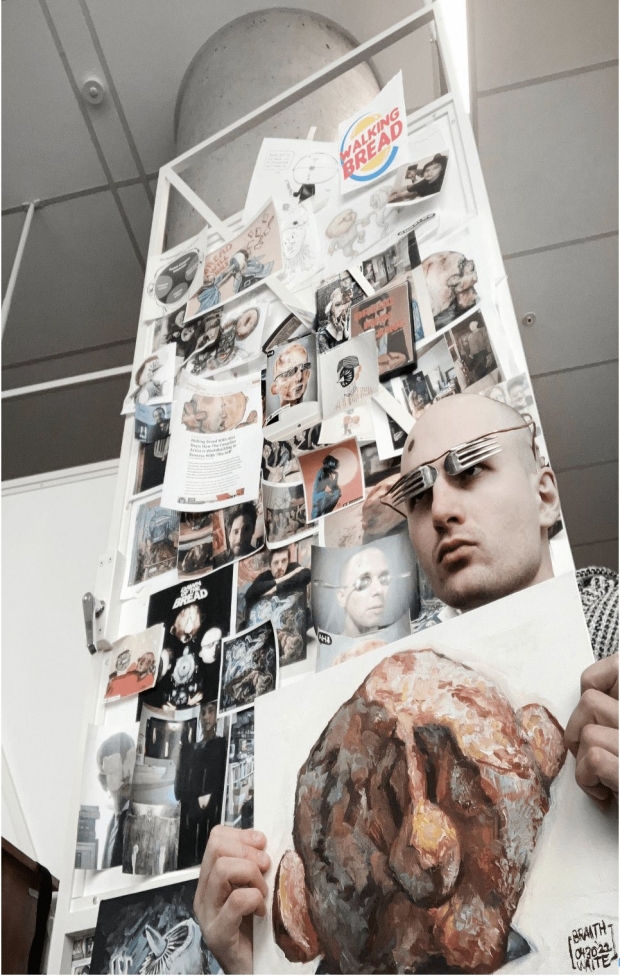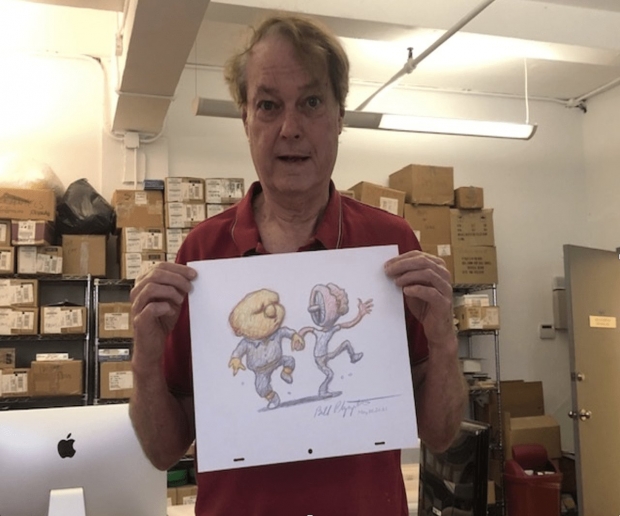Exploring Alex Boya’s world making, Zombie bread baking, and animation process.
In 2016, I began doing cognitive research at the NFB/ONF (National Film Board/ Office national du film du Canada) focusing on the animation process through the design pipeline. It was a bucket-list desire of mine that was granted by Michael Fukushima, the former Executive Producer of the English Animation Studio of the NFB. He took a significant risk that my research methods would not impede or damage anyone’s creative process.
Among the very first animators who let me into the most critical early stages of the animation process was Alex Boya. Alex was doing late development/ early pre-production sketches and drawings for Turbine (2018), his surrealistic film about love, machines, and war. My opening question for Alex in each of the design phases of the main pipeline stages (e.g., development, pre-production, production, post-production) was always “what are you working on now?”
I never asked, “what else are you thinking about?”
In recent interviews with Alex, it turns out that as early as 2015 he was thinking about something else: he was world-building, creating a community in which to construct a fictive animation series. Together, this would be his metaworld, inhabited by a real-world forum of animators, filmmakers, artists posting thoughts and images for Alex’s current episode in his animation series, The Mill World: Walking Bread.
Alex’s office is covered with copies of forum-created artworks, some of which may inspire the various versions of his film, each of which are styled in the personal passion of the poster, from Biopunk to Steampunk, Gothic science fiction to Biohorror, and every genre in-between.
Alex proudly showed me a painting that was posted on his GIPHY site. “This was created by Sam Braithwaite, known for their brilliant work, who recently sent me an absolutely absorbing interpretation of the Bread Zombie in our ‘Walking Bread’ world-building experiment.”
Below is a rich, yet nightmarish painting based on Turbine by Joshua J. Stewart:
And here legendary animator, Bill Plympton, holding his drawing of the “Turbine” and a Walking Bread “zombie in a waltz:”
Janet Blatter: What was the inspiration for creating a forum? When/how did it begin?
Alex Boya: The inspiration behind the initiation of the Walking Bread project was the desire to create a unique and creative community centered around world-building, storytelling, and character development, with a focus on the genre of apocalyptic and post-apocalyptic scenarios. But people are at the core of this project.
Watching the latest animatic of his upcoming animation. I was struck by Alex’s use of color and 3D elements, which shared the screen with his previous black and white 2D shapes and textures. Alex’s past work in engineering and medical illustration had an obvious connection to the black and white and 2D precision he used in Turbine. While his GIPHY site’s heading as “medical expressionism” is dead-on, Alex’s current use of 3D and color was something new to his animation.
Note how Alex described his current production process:
- “At the moment, I’m conducting research and gathering information to establish the conceptual and thematic foundations of the animation. The outcome of this phase will be a detailed concept or pitch document that outlines the project's vision, including the story, characters, visual style, and overall direction of the animation.”
- “This phase is essential in establishing the conceptual and thematic foundations of the animation. During this stage, I conduct research to gather information and inspiration, such as reviewing related literature, conducting interviews with subject matter experts, exploring visual references, and gathering relevant data.”
- “This community research phase is critical for ensuring that the animation is grounded in accurate representation of the subject matter, as well as helping to establish the overall tone and style of the animation. The outcome is a detailed concept or pitch document that outlines the project's vision, including the story, characters, visual style, and overall direction of the animation.”
Significantly, Alex’s toolkit includes AI. But Alex is not just “prompting” in CHAT GPT, Midjourney, DALL-E, or Stable Diffusion for imagery; he is building “Walking Bread” as a community of fellow artists who can have their visual interpretations, whether free-drawn or as AI images, incorporated in the Walking Bread Community.
Alex Boya also created an experimental animation technique called "genomic expressionism." The technique involves digitizing hand-drawn images, using Depth-Aware Video Frame Interpolation algorithms for inbetweening, and converting them to context-sensitive volumes and textures using prompt design. The resulting animation sequences combine the lifeline of a hand-drawn sketch with the photographic depth of stop-motion animation.
For Alex, the idea of having a social forum that could serve to inspire the story and the imagery, is integral to the animator’s process itself. For him, independent, non-commercial enterprises and artists are invigorated by the computer social platforms. And it may offset AI’s side-effect of losing people who contributed to essential social forums animators need during their work. It is the social loss that is Alex’s main concern about AI, both in the very biases in AI algorithms, and the disappearance of workers necessary for the animator’s inspiration and feedback during the process:
- “With the advent of some automation that uses LLM (Large Language Models), it may seem the initial architects embeds either consciously or unconsciously, their biases, and from there on, the conversation is over. You basically compound that initial seed to infinity without a forum.”
- “And by collapsing the communication process in some of the current AI algorithms, you’re basically removing the forum. So, you de-leveraged the visual artist, the visual communicator. Human communication has been deleveraged.”
According to Alex, one of the most significant differences between commercial and independent animation studios and animators is the impact on human communication and building of the social processes integral to the animator’s creative process.
He explains, “Independent, experimental, individual, art-based animation is very much a social process where we want to discover as much as recognize. That is why I think the healthy way is to reveal the uncertainty in the forum where you have a diverse exchange of ideas. But it has to come from a place where the incentive is not only commercial in the traditional sense, but can have a diverse exchange of ideas, where the incentive is not just the end result of a commercial product but could be in the actual pipeline. So, there’s a way of cooperating in the private and public sector for creating a new kind of community, a creative laboratory for human expression to co-evolve with technology. I’ve had the opportunity of being supported by the National Film Board of Canada in creating this kind of social laboratory for myself where HCI (Human-to-Computer Interaction) forms of co-evolution centers on the human in future communication forums. Given the pressing need for HCI ecosystems and media platforms, multifaceted public institutions like the NFB have become more essential than ever before.”
One of Alex’s most intriguing, if not controversial views, is his questioning the source and function of art as solely expressing the individual artist’s identity and uniqueness, and the source of creative thoughts:
- “Indeed, artists have a need to pass along something that is more than ourselves. The thing, the ideas that we imagine and produce - like all of what we experience - is not entirely ours; we are a vessel.”
- “I was just the inspiration and all your life you’re just trying to pass it on. I’m nobody. ‘Alex’ is just a kid who happened to see something in the park one day when he was two years old, then saw a dead bug, and made a connection between the two things, and drew it.”
- “Artists do not own the meaning of their own work. Art is a living organism that reproduces itself through us, embodying a self-aware pleasure in its own existence. It has never been “mine” It’s always seemed very extraterrestrial to me this idea of – probably for reasons beyond my understanding - that I would protect my narrative. It’s very foreign to me.”
- “What’s more interesting for me is the appropriation of my artwork, sculpting a reception of the artwork out of context, different angles where people make their own analogies to it. It’s Street Art in Cyberspace via database storytelling where time is collapsed in looping animations. I find that more interesting, and that’s why I’m inviting artists to do the same thing, to make their connections with bits and pieces of my work.”
So far, 7,000 of Alex’s GIFs to GIPHY resulted in 3.6 billion views. To display “Walking Bread” GIFs on the full spectrum of social media platforms, from Instagram to Reddit, the community has integrated GIPHY's API, making it easier for them to engage with their audience and reach a wider audience by serving as the central hub for Walking Bread media.
JB: So, what makes you hopeful about AI?
AZ: What AI is doing now is bringing back creative focus to the animator because since the labor is no longer as much of a chore as it used to be, there’s more opportunities for curatorial/evaluative decision-making, because you’re no longer stuck in the how, you can focus on the why.
I’m not against AI technology, but I also see more of the social value possible with social media platforms of HCI. While there are very useful ways where AI works, I believe in the social media more than AI in that there are many ways to collaborate and co-evolve with the developing techniques.
While some commercial enterprises, which may have bottom-line incentives to deleverage the laborer via automation, may see their expenses for human talent shrink, public institutions will take responsibility to swim against the current, taking the path of most resistance, as the human process is as important to them as the actual product.
I’m lucky to have my community and pipelines supported by a cultural institution, and I think that’s my point. Basically, when you’re working with something that is as labor intensive as animation, you get lost in the “how” can I do it, and you forget the “why” quite often. One advantage of creative laboratories supported by cultural institutions is that AI can streamline certain tasks, without compromising the authenticity of human self-representation. These labs avoid prompt-based or automated replacements of human communication, preserving the unique lifeline of human utterance.
As early as 2016, Alex was shaping his world, story and images using social platforms communities, and prompting early CHAT GPT for ideas by November 2022. But most of this interview occurred when Open AI’s CHAT GPT4 and Microsoft’s Bing had just emerged. Almost immediately, the media was dominated by technophobes, neo-Luddites who vowed that humans will soon be replaced by “sentient” computers. And when I asked him about copyright ownership, he acknowledged that “the ownership of the content on ‘Walking Bread’ is ambiguous or unclear.” But he emphasized that he saw his content on “Walking Bread” as the artist’s attempt at “social media community building” with a focus on images, stories, and perspectives both within Canada and internationally.
So, Alex Boya is among the cautiously optimistic artists who embraces the positive potentials of AI. He hopes to create a world where computer-generated programs can contribute to the technological and production goals, while still supporting the critical human social resources and infrastructure needed to create animations, especially in the inherently open and wild thinking in the early stages, where risk is low, potential is high, and free association feeds creativity.
The bread is still rising; I can’t wait to eat.
For more on Alex Boya and the Community:
GIPHY: https://giphy.com/alexboya











